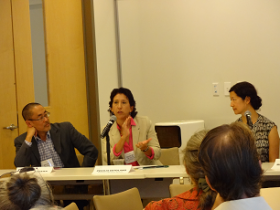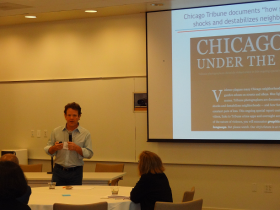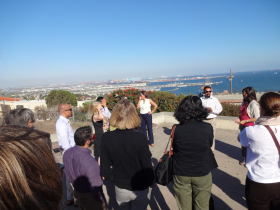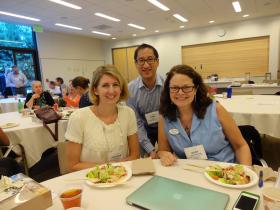You are here
Funding for the Future: Reflections from HEFN’s 2014 annual meeting

This blog post was authored by HEFN Director Kathy Sessions.
“We have faith in a different vision of 2029, because we have witnessed our own power to change the future.” These encouraging words from Michele Prichard of the Liberty Hill Foundation opened and framed HEFN’s 2014 annual meeting, held on October 27-28 in Los Angeles, California.
On the occasion of HEFN’s 15th anniversary, funders reflected on the past fifteen years’ remarkable progress in understanding and improving environmental conditions affecting health. Those reflections provided the backdrop for two lively days exploring visions, tools, and strategies for shaping healthier realities by 2029. The Kresge Foundation’s David Fukuzawa pointed to futurists’ varied possible public health scenarios for 2030 which illustrate how much the shape of the future “is in our hands.”
To look ahead, we focused on contemporary challenges through a problem-solving lens. A lot of environmental health and justice work begins with concerns about problems--whether it’s a local cancer cluster, indoor mold and lead, outdoor traffic pollution, toxics in everyday products, or unregulated drilling close to homes and drinking water. In the HEFN meeting, funders explored arenas in which people are developing alternatives with potential to make big, positive changes over the long run.
David Bornstein at the HEFN 2014 Annual Meeting. Image source: Andrea LevinsonAs speaker David Bornstein noted--drawing on his experiences as New York Times Fixes columnist and Solutions Journalism Network cofounder--often the best way of interesting people in a problem is by focusing on solutions. Throughout the HEFN event, speakers and participants shared solutions stories, gaining insight and inspiration from one another.
Themes from this problem-solving menu:
Alternatives are emerging. The meeting explored innovations to address common environmental health hazards like toxic materials, dirty energy production, and the proximity of people to pollution. Green chemistry pioneer John Warner talked about transforming chemists’ ability to design materials with health and environmental sustainability in mind. Stanford professor Mark Jacobson highlighted Solutions Project research concluding that the US can transition to 100% renewable energy using today’s technologies. Local LA-area organizers talked about land use changes and local control measures helping buffer residents from major pollution sources.
Data tools are getting better. Several speakers described steady improvements in tools to monitor, analyze, and act on environmental hazards. Occidental College professor Jim Sadd noted an environmental justice screening method and a California Environmental Screen identifying toxic “hot spots” of pollution. Open data expert David Eaves described an exciting convergence of information technologies and social activism, spurring power-building through data-sharing in environmental health and justice.
Core values can become more central to business and economic development. A business panel--including speakers from Kaiser Permanente, Walmart and Steelcase--discussed corporate efforts to address toxicity and sustainability along the supply chain. Regional economic development was the focus for Kentuckians for the Commonwealth organizer Sara Pennington, who talked about their values-guided work in Appalachia on transitions to sustainable energy and a better quality of life.
Funders on the Tour of the Ports of Los Angeles and Long Beach at the HEFN 2014 Annual Meeting. Image source: Andea LevinsonLong-term organizing is making big strides. Angelo Logan of East Yard Communities for Environmental Justice shared stories from years of organizing in neighborhoods affected by ships, trains, and trucks around the Los Angeles and Long Beach ports. Some meeting participants visited communities near those ports and heard of wins, including a clean trucks initiative reducing diesel emissions, the establishment of a community benefits fund, and inclusion of community voices on ports commissions. Another meeting group toured LA neighborhoods being impacted by oil extraction, learning of nimble organizing to address the rapid expansion of fracking, acidizing and other extreme oil extraction techniques in the midst of residential areas.
Persistence towards comprehensive policy solutions is essential. Several speakers noted policy progress in addressing specific environmental health problems as stepping stones towards more comprehensive reforms. NRDC’s Veena Singla, for example, praised California’s new law improving consumer information about flame retardants in furniture while flagging the limits of “whack-a-mole” wins--banning one chemical of concern only to see another pop up--versus a full overhaul of the Toxic Substances Control Act. North Carolina Representative Pricey Harrison shared a legislator’s perspectives on the long-term efforts needed to improve state policies on toxics, energy policy, and voter rights. Economic development expert Cecilia Estolano pointed to upcoming milestones towards improving the democratic process and the policies it produces, through work on redistricting and the 2020 Census.
Movement-building from the ground up is key. Speakers highlighted power-shifting gains made, or in sight, from organizing in communities affected by environmental hazards and injustice. California Calls’ Anthony Thigpenn shared insights from civic engagement movement-building, and MoveOn.org’s Victoria Kaplan talked about online organizing. La’Tasha Mayes of New Voices Pittsburgh highlighted expanding organizing of black women and girls. The Asian Pacific Environmental Network’s Miya Yoshitani shared an optimism for the future rooted in steady power-building among Asian-Americans and Pacific Islanders and their partners for environmental health and justice.
HEFN members Jennifer Chheang, Earl Lui and Mary Silverstein at the HEFN 2014 Annual Meeting. Image source: Andrea LevinsonRelationships matter. Throughout the HEFN meeting, examples of progress made through partnerships surfaced. People shared notes about how environmental health and justice work is advancing as diverse skills and stakeholders come together, including from communities, nonprofits, academia, agencies, businesses, the media, and more. Funders are building the field and its power to make transformative changes by supporting communications and relationships across many efforts. And funders are strengthening their own grantmaking by learning and working together.
Happy fifteenth anniversary, HEFN, and here’s to another fifteen years of funder learning, collaboration, and impact!
From our Blog
Upcoming Events
|
Jul 29 2024 Zoom |
Jul 30 2024 Zoom |




